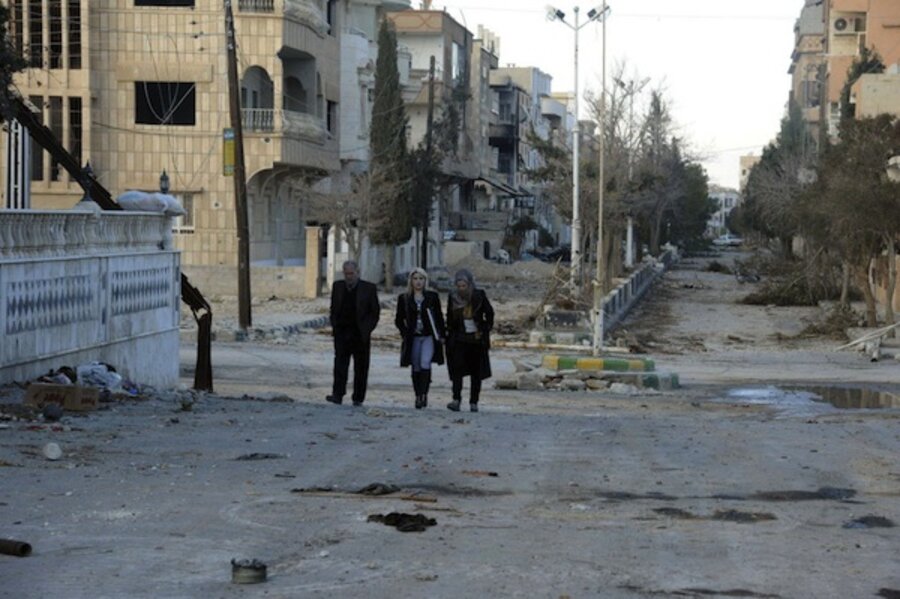Syrian army captures highway, clearing path for chemical weapons removal
Loading...
| Beirut, Lebanon
In a move that could prove vital to implementing the deal to eliminate Syria's chemical weapon, government forces have reestablished control of a town overlooking a key highway linking Damascus to the coast after weeks of fighting in the area, Syrian state media reported Monday. This military advance means that a first tranche of chemical weapons could be extracted by a Dec. 31 deadline.
Even with its latest apparent advance, forces loyal to President Bashar al-Assad still do not fully control the highway that links Damascus to the northern city of Homs, before reaching the Mediterranean coastline at Tartous. Government troops face the threat of ambush by rebel groups north of Damascus. As a result, international monitors may for now consider this route too dangerous for the safe passage of 500 tons of lethal “priority” chemical agents marked for imminent removal.
Securing the highway is seen as crucial for the safe overland removal of the most dangerous batch of chemical agents in Syria’s arsenal. Since October, the Organization for the Prohibition of Chemical Weapons and the United Nations have been working to trace, verify and secure the government's estimated 1,300 tons of chemical agents. An oft-cited concern is how to safely transport these materials out of the country during a civil war with shifting fronts.
SANA, the Syrian state news agency, said on Monday that the military had retaken the town of Nabk, 40 miles north of Damascus, “after a series of successful operations.” It said that the army was pursuing rebels in the surrounding farmland.
Nabk lies at the northern end of the Qalamoun area, a mountainous territory between Damascus and Homs that lies adjacent to the Lebanese border.
Last month, the military, supported by the Lebanese militant group Hezbollah and Iraqi paramilitary groups, launched an offensive against rebel forces in Qalamoun. Nabk would be the third town to fall to the army since the campaign began, but it leaves a large swathe of Qalamoun with a rebel presence, including two towns south of Nabk that lie close to the north-south highway.
The operation to remove the chemical weapons is the result of a US-Russia brokered agreement in September. The Assad regime agreed to hand over its chemical weapons in exchange for a postponement of a planned campaign of US-led air strikes against the Syrian military.
So far, the operation has run smoothly: The Organization for the Prohibition of Chemical Weapons, known as the OPCW, says it has already completed the verification process and destroyed production facilities and munitions for chemical agents.
Deadline for destruction
Under the agreement, Damascus is responsible for dismantling its chemical weapons program and removing all its components. That includes the 500 tons of “priority” chemical agents, consisting of up to 22 tons of sulphur mustard, a blistering agent, and two precursor chemicals each for sarin and VX nerve agents.
The priority agents are required to be out of the country by Dec. 31 and destroyed no later than Mar. 31.
The remaining 800 tons of the inventory consists of mainly industrial chemicals that are due to be removed and destroyed by Feb. 5. Some 35 private companies have tendered bids to destroy them.
“These are, for the most part, run-of-the-mill industrial chemicals, and a lot of them would not even have to be removed and destroyed had they been in Syria for legitimate purposes,” says Michael Luhan, a spokesman for the OPCW. "But it’s because they are there as part of the production chain for chemical warfare agents that they have to be removed and destroyed."
Seaborne incineration
Last month the US offered to destroy the priority chemical agents on a specialized ship through the process of hydrolization. Hydrolization involves the addition of hot water or caustic agents, such as sodium hydroxide, which destroy the toxicity of the agent. The neutralized agent can then be incinerated or given similar treatment as sewage water. Although no final decision has been taken, the OPCW is seen as likely to accept the US offer.
The bigger headache is ground transportation in Syria. Since moving the chemical agents through neighboring Lebanon or Iraq would violate international conventions, the only other outlet is Syria’s own coastline, which remains under regime control. Syrian authorities have proposed that the agents are loaded at the northern port of Latakia. But this still means that the consignment must pass through the contested battlefields around Qalamoun.
“Because our inspectors have to accompany this stuff, we have to keep eyes on the materials right through to the destruction point, (and) the Syrian government has to do whatever it can to ensure the security of those activities,” says Mr. Luhan, speaking from Oslo, Norway, where the OPCW is due to receive the Nobel Peace Prize during a ceremony Tuesday.







